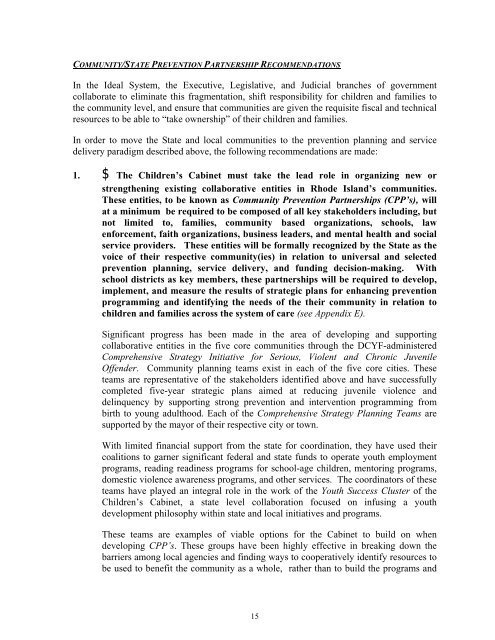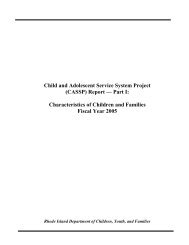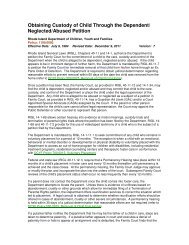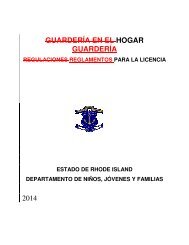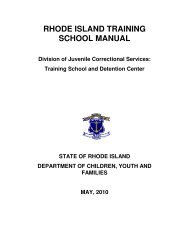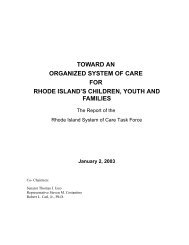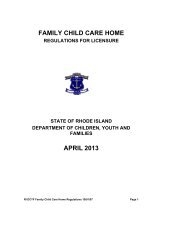system of care for rhode island's children, youth and families
system of care for rhode island's children, youth and families
system of care for rhode island's children, youth and families
You also want an ePaper? Increase the reach of your titles
YUMPU automatically turns print PDFs into web optimized ePapers that Google loves.
COMMUNITY/STATE PREVENTION PARTNERSHIP RECOMMENDATIONS<br />
In the Ideal System, the Executive, Legislative, <strong>and</strong> Judicial branches <strong>of</strong> government<br />
collaborate to eliminate this fragmentation, shift responsibility <strong>for</strong> <strong>children</strong> <strong>and</strong> <strong>families</strong> to<br />
the community level, <strong>and</strong> ensure that communities are given the requisite fiscal <strong>and</strong> technical<br />
resources to be able to “take ownership” <strong>of</strong> their <strong>children</strong> <strong>and</strong> <strong>families</strong>.<br />
In order to move the State <strong>and</strong> local communities to the prevention planning <strong>and</strong> service<br />
delivery paradigm described above, the following recommendations are made:<br />
1. $ The Children’s Cabinet must take the lead role in organizing new or<br />
strengthening existing collaborative entities in Rhode Isl<strong>and</strong>’s communities.<br />
These entities, to be known as Community Prevention Partnerships (CPP’s), will<br />
at a minimum be required to be composed <strong>of</strong> all key stakeholders including, but<br />
not limited to, <strong>families</strong>, community based organizations, schools, law<br />
en<strong>for</strong>cement, faith organizations, business leaders, <strong>and</strong> mental health <strong>and</strong> social<br />
service providers. These entities will be <strong>for</strong>mally recognized by the State as the<br />
voice <strong>of</strong> their respective community(ies) in relation to universal <strong>and</strong> selected<br />
prevention planning, service delivery, <strong>and</strong> funding decision-making. With<br />
school districts as key members, these partnerships will be required to develop,<br />
implement, <strong>and</strong> measure the results <strong>of</strong> strategic plans <strong>for</strong> enhancing prevention<br />
programming <strong>and</strong> identifying the needs <strong>of</strong> the their community in relation to<br />
<strong>children</strong> <strong>and</strong> <strong>families</strong> across the <strong>system</strong> <strong>of</strong> <strong>care</strong> (see Appendix E).<br />
Significant progress has been made in the area <strong>of</strong> developing <strong>and</strong> supporting<br />
collaborative entities in the five core communities through the DCYF-administered<br />
Comprehensive Strategy Initiative <strong>for</strong> Serious, Violent <strong>and</strong> Chronic Juvenile<br />
Offender. Community planning teams exist in each <strong>of</strong> the five core cities. These<br />
teams are representative <strong>of</strong> the stakeholders identified above <strong>and</strong> have successfully<br />
completed five-year strategic plans aimed at reducing juvenile violence <strong>and</strong><br />
delinquency by supporting strong prevention <strong>and</strong> intervention programming from<br />
birth to young adulthood. Each <strong>of</strong> the Comprehensive Strategy Planning Teams are<br />
supported by the mayor <strong>of</strong> their respective city or town.<br />
With limited financial support from the state <strong>for</strong> coordination, they have used their<br />
coalitions to garner significant federal <strong>and</strong> state funds to operate <strong>youth</strong> employment<br />
programs, reading readiness programs <strong>for</strong> school-age <strong>children</strong>, mentoring programs,<br />
domestic violence awareness programs, <strong>and</strong> other services. The coordinators <strong>of</strong> these<br />
teams have played an integral role in the work <strong>of</strong> the Youth Success Cluster <strong>of</strong> the<br />
Children’s Cabinet, a state level collaboration focused on infusing a <strong>youth</strong><br />
development philosophy within state <strong>and</strong> local initiatives <strong>and</strong> programs.<br />
These teams are examples <strong>of</strong> viable options <strong>for</strong> the Cabinet to build on when<br />
developing CPP’s. These groups have been highly effective in breaking down the<br />
barriers among local agencies <strong>and</strong> finding ways to cooperatively identify resources to<br />
be used to benefit the community as a whole, rather than to build the programs <strong>and</strong><br />
15


